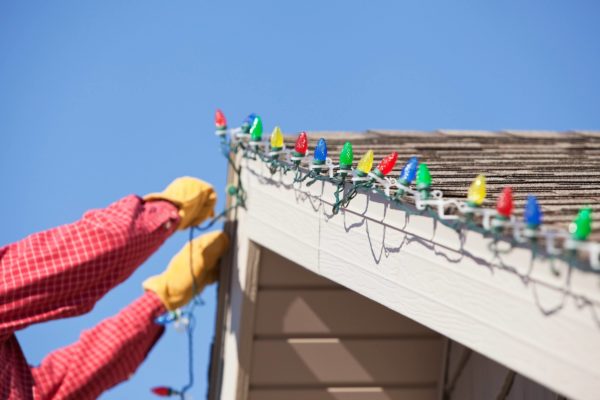The Holiday season brings lots of decorations, especially lights. If you’re like most people, you’re likely to use tens and hundreds of Christmas lights to decorate your tree and home this year. Before you go making grand plans to outdo Clark Griswold, though, it’s important to consider the effect that Christmas lights have on your home’s electrical system. Taking your home’s electrical system for granted can cause serious safety hazards that can quickly put a damper on your holiday plans. To keep you and your family safe this season, here are a few insights about holiday lights from your friends at Thermo Direct.
Concentrated Draw
One potential problem with Christmas lights is that they constitute a concentrated power draw in your home. Whether it’s the plug closest to your Christmas tree or the single outdoor plug powering your outdoor Christmas lights, most people opt for single-source power for their holiday lights. This puts a significant strain on a single electrical circuit which likely only has wires rated to safely handle 15 amps. Exceed this limit, and you may end up with a tripped breaker. If the breaker doesn’t trip for some reason, the wires could overheat and cause a fire in your home. That’s why Thermo Direct recommends diversifying your power sources whenever possible. You can use heavy-duty extension cords to run power from multiple circuits to prevent overloads.
Overloaded Power Strips
Another way to overwhelm the electrical circuits in your home is to use multiple power strips to provide electricity to your holiday decorations. In most cases, power strips can handle up to 15 amps safely. However, they’re pulling all of that power from one outlet. Therefore, if you max out a power strip on a circuit that has something else plugged into it, you can quickly overload the circuit. Another note about power strips is that you should never plug a space heater into even the most robust power strip. Most space heaters draw 12 amps of power or more, meaning you’ll quickly overload the power strip if you plug anything else into it. This can result in a fire if the power strip doesn’t have any internal protection mechanisms. Basically, Christmas lights and space heaters shouldn’t ever mix.
Electrical Shorts
In general, holiday lights and decorations aren’t known for being the most well-made electrical devices. Bad wiring, frayed cords, and other issues are fairly common among these items. When an electrical device has bad wiring, for example, an electrical short is likely to occur. As long as your circuit breakers are operating properly, an electrical short usually causes nothing more than a tripped breaker. However, electrical shorts can also cause fires, electrical shock, and other problems if the shorts happen in the wrong place at the wrong time. Another common cause of electrical shorts when it comes to Christmas lights is when outdoor lights get wet. Some people may decorate the exterior of their houses with lights that aren’t rated for outdoor use. As soon as it rains, water will seep into the bulb sockets and cause the circuit to short out. Repeated electrical shorts can cause long-term damage to your electrical system that requires professional assistance to repair.
LED Bulbs
When decorating your home in Holly Springs, it’s important to try and keep your electrical load to a minimum, even in situations when you’re able to properly distribute the electrical load across multiple circuits. The best way to limit your energy use is to invest in LED Christmas lights. LED lights are brighter, last longer, and consume far less energy. Depending on the type of lights you’re replacing, you may use as much as seven times less energy by switching to LED lights. This can allow you to add more lights to your home without worrying about overloading your home’s circuits. Thermo Direct wants you to keep in mind, though, that you can still cause a safety hazard if you add too many sets of LED lights to a circuit. Therefore, carefully check each set of lights to see how much power they draw to ensure the total power draw won’t exceed the safe limits of your home’s circuits.
Unshielded Power
An unexpected problem that some people run into when using Christmas lights is that it can introduce an electrical hum into their home audio equipment. All electrical cords produce an electrical hum when electricity is running through them. On top of that, LED bulbs produce a hum of their own that can be even more intense than a standard electrical hum. The final straw is that the electrical cords in most Christmas light sets aren’t well insulated. Thus, the electrical hum can escape the electrical cord and feedback into your home’s electrical system. For the most part, hums coming from power cords lack the intensity necessary for humans to hear them. However, if there is an amplifier or other audio device on the same circuit as your Christmas lights, the amplifier may pick up the hum and amplify it to the point that it becomes quite annoying. To overcome this problem, Thermo Direct recommends either moving the lights to a different circuit or protecting your speakers with a power conditioner.
Flickering Lights
Another reason you should avoid adding too many Christmas lights to your home’s electrical circuits is that it can cause the other lights in your home to flicker. Since many Christmas decorations are often cheaply made, their power draw can be quite inconsistent. Then, if you have too many strands of lights or other decorations on one circuit, the power available to other devices on that circuit can fluctuate if the total draw is nearing the circuit’s limit. This can result in your lights flickering randomly while the lights or other decorations are turned on. It’s important to remember, though, that flickering lights can have a variety of causes. If unplugging the Christmas lights doesn’t fix your flicker, it’s a good idea to call Thermo Direct for further assistance.
Careful Inspections
Even if you do everything right when it comes to holiday lights, things can still go wrong. That’s why it’s a good idea to periodically inspect the lights, switches, outlets, and other components of your home’s electrical system each season. Check to make sure that all of the electrical cables are in good condition, that there’s no sign of water damage to any exterior decorations, and that none of your home’s outlets or switches are hot to the touch while you’re running your lights. These checks can help prevent a major catastrophe by catching small problems before they become big.
Your Holiday Lighting Experts
At Thermo Direct, we love helping our customers enjoy the holidays. That’s why we provide electrical repair, whole-home surge protection, generation installation, furnace maintenance, duct sealing, and much more. With over 20 years of experience, we continue to work hard to stay up-to-date on the latest innovations in home comfort technology while also serving our customers with the highest standard of care. This dual approach to excellence is one reason why we consistently receive five-star customer reviews. To learn more about keeping your home safe this holiday season, contact us at Thermo Direct today.









